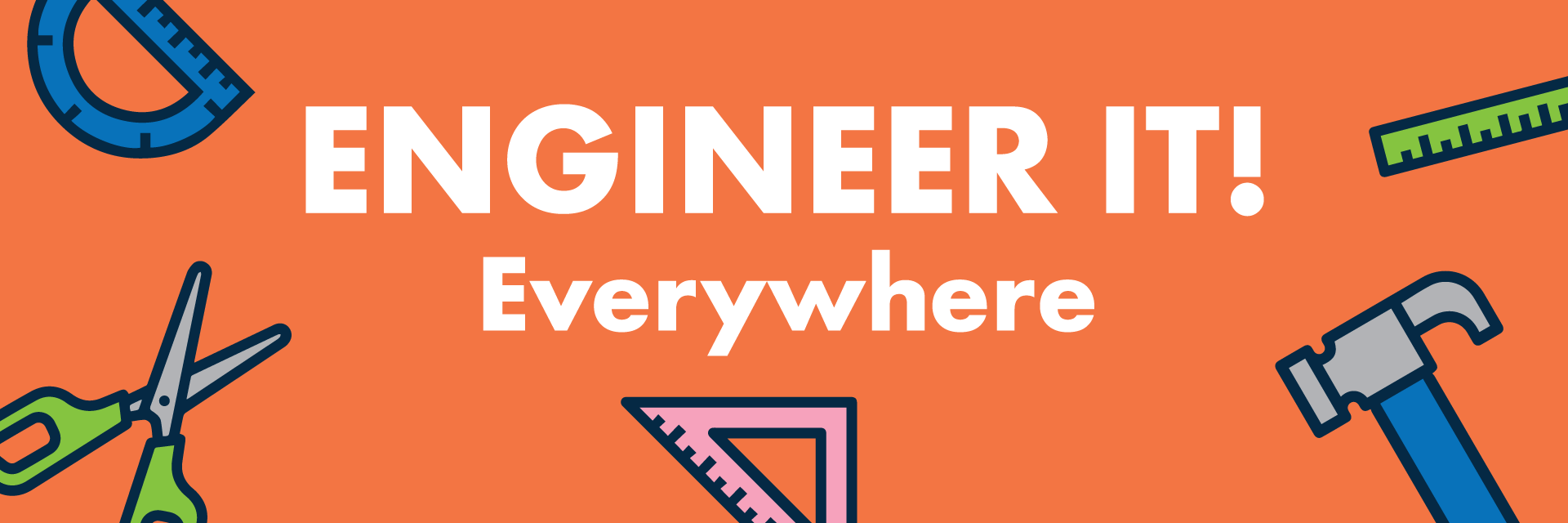
Engineer It! Everywhere
Try these engineering design challenges with materials you might already have at home or school! The goal is to problem-solve like an engineer and have some hands-on, learning fun. Each challenge has a list of suggested materials, background science concepts, and some options to extend the challenge. We also walk you through the steps of the Engineering Design Process (define the problem, plan a solution, create a prototype, test your design, and improve your creation) with guiding questions to help along the way.
Please share your creations with us via Facebook or email so we can see all of our ECHO engineers in action! Also we look forward to seeing all our aspiring inventors in ECHO’s Engineer It exhibit space to continue the designing and prototyping!
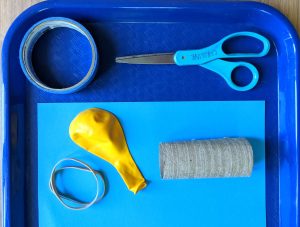 Suggested Materials:
Suggested Materials:
Rubber bands
Balloon
Toilet paper tube
Paper
Scissors & tape
STEM Concepts: There are four basic forces acting on your rocket – lift, thrust, drag, and weight. Lift (upwards) and thrust (forwards) are the forces that will send your rocket flying!
Extensions: Try using your rocket launcher to launch different types of rockets – which rockets fly highest? Straightest? Furthest?
THE ENGINEERING DESIGN PROCESS
Define the Challenge: Design and build a rocket and launching station.
Plan Your Design: What will your rocket be made of? How will your rocket get the energy it needs to fly?
Create a Prototype: Build a test rocket and launcher!
Test your Creation: Did your launcher work? How far did your rocket go?
Improve Your Design: Can you design a rocket that travels farther? How can you make your launcher more powerful?
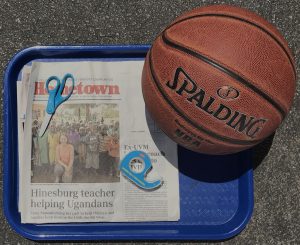 Suggested Materials:
Suggested Materials:
Basketball, soccer ball, or other similar object
Newspaper
Tape & scissors
STEM Concepts: You’ll have to explore geometry and figure out which shapes are the strongest as you build your tower. You’ll also have to figure out how to use newspapers – which we don’t normally think of as strong building material – to construct a sturdy tower.
Extensions: Try an even heavier object. Or, change your goal to building the tallest tower! Can you build a tower that can withstand wind from a fan?
THE ENGINEERING DESIGN PROCESS
Define the Challenge: Design a newspaper tower that can keep a basketball off the ground. It should be able to hold the basketball up for at least 10 seconds.
Plan Your Design: What shapes will help your tower withstand the weight of a basketball? How will you attach the different elements of your tower?
Create a Prototype: Construction time!
Test your Creation: Does your tower stand on its own? Can it support the weight of a basketball?
Improve Your Design: Where does your tower need support?
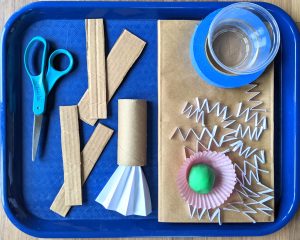 Suggested Materials:
Suggested Materials:
Crash test object – a ball of playdough, an action figure with removable parts, light up bouncy ball (any object that visibly, reversibly changes when it crashes into another object)
Recyclables
Scissors & tape
STEM Concepts: When two objects collide, energy moves between them. Since the stairs are stronger than your design, your design will have to absorb the energy (or shock) and keep your object safe.
Extensions: Can you find any real life examples of shock absorbing systems? What are they made of?
THE ENGINEERING DESIGN PROCESS
Define the Challenge: Design something that will keep your object safe as it tumbles down the stairs.
Plan Your Design: With the materials you have, what would you like to try? What sorts of materials will help absorb shock?
Create a Prototype: Build your design.
Test your Creation: Will your crash test object and design make it down the stairs undamaged?
Improve Your Design: How can you make your design even stronger and more shock absorbing? For an extra challenge, limit the number of materials in your design, eliminate tape, or find a safe way to drop your design from way up high.
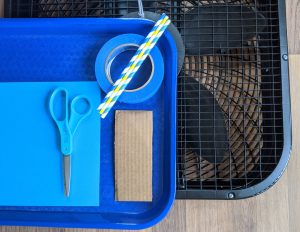 Suggested Materials:
Suggested Materials:
Box fan (or other wind source)
Cardboard boat with a flat bottom
Cardstock, construction paper, and/or cereal box cardboard
Dowels, straws, or sticks
Tape & scissors
The Challenge: Can you design a sail that harnesses the power of wind to move your cardboard boat?
STEM Concepts: You will be exploring how the shape of a sail changes the way it moves. Try placing your sail at different angles, too!
Extensions: Incorporate some materials science and try making sails out of other supplies – what works best? What doesn’t work? What are sailboat sails made of?
THE ENGINEERING DESIGN PROCESS
Define the Challenge: Set up a fan, a starting spot, and a target (maybe an X of tape on the floor!). Design a sail that uses the power of the wind to move your cardboard boat to the target.
Plan Your Design: What shape do you want your sail to be? How will you keep it in position when the fan turns on?
Create a Prototype: Build your sailboat!
Test your Creation: What happened to your boat when you turned the fan on to test your design?
Improve Your Design: Does your sail need to be adjusted? Is it a good size?
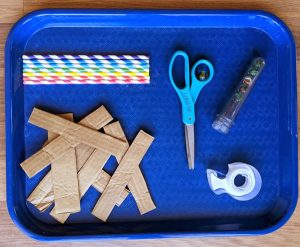 Suggested Materials:
Suggested Materials:
- A shallow box or tray (to use as a base)
- Straws, twigs, or strips of cardboard
- Scissors
- Tape or glue
- Marble(s)
The Challenge: Can you design a maze for a marble?
STEM Concepts: Your marble doesn’t move on it’s own – gravity & the force you apply when you move the maze help it get going! Investigate Newton’s Laws of Motion, and see if you can find evidence of all three in your marble maze.
Extensions: Can you find other materials to add ramps or tunnels to your maze? Try sharing your maze with someone, and see if they can move the marble through it!
THE ENGINEERING DESIGN PROCESS
Define the Challenge: Design a maze for a marble. The marble must have an entrance (or start), and exit (or finish). There should also be lots of obstacles! For an extra challenge, add some tricky dead end paths.
Plan Your Design: How will you create a challenging maze? How will the marble move through your maze?
Create a Prototype: Build a version of your maze. Follow the path that you predict the marble will take.
Test your Creation: Does your marble go where you predicted, or expected?
Improve Your Design: What other obstacles can you add?
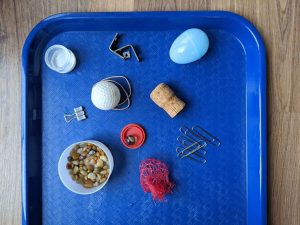 Suggested Materials:
Suggested Materials:
- Small things that float
- Small things that sink
- Things that attach – paper clips, tape, etc.
- Bowl or basin filled with water
The Challenge: Can you design a fish that doesn’t sink or float to the surface, but instead stays in the middle of the water column?
STEM Concepts: Many fish need to be able to move through the water without sinking all the way or floating to the surface – they have to maintain neutral buoyancy by balancing gravity (which pushes them downward) and water’s buoyant force (which pushes them upward).
Extensions: Do some research. How do fish prevent themselves from sinking to the bottom of Lake Champlain?
THE ENGINEERING DESIGN PROCESS
Define the Challenge: Design a fish that stays underwater – it doesn’t sink to the bottom or rise to the surface.
Plan Your Design: What makes something sink or float? What materials could you use to design your fish?
Create a Prototype: Build your fish!
Test your Creation: Does your fish float? Sink? Stay in the middle?
Improve Your Design: How can you change the density* of your fish? Could you find any materials that were already neutrally buoyant?
*Density = Mass / Volume. In this experiment, we can think of density as how heavy something is compared to its size. Even though they are the same size, a golf ball will sink but a ping pong ball will float. That’s because the golf ball has a higher density. In order to accomplish this challenge, your fish needs to have the same density as water!
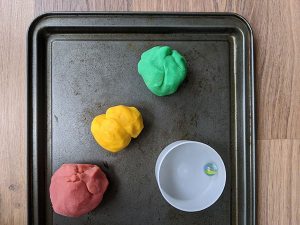 Suggested Materials:
Suggested Materials:
- Baking sheet
- Playdough
- Marbles
- Stopwatch
The Challenge: Can you create a marble run that takes a marble more than 15 seconds to complete? Stand a baking sheet up against a wall and create a playdough track!
STEM Concepts: When you drop a marble, gravity accelerates it towards the ground. What does it take to slow that acceleration?
Extensions: Break free from the baking sheet – what other materials do you have around your home that could create a track, and what other surfaces could you use to anchor your marble run?
THE ENGINEERING DESIGN PROCESS
Define the Challenge: Design a marble run that takes more than 15 seconds for a marble to move through using only playdough and a cookie sheet.
Plan Your Design: How can you slow the marble down without completely stopping it?
Create a Prototype: A prototype is like a first try – see if you can build what you imagined.
Test your Creation: Did your marble stay on the track? Did it move too quickly, or stop moving before the end? What happened? Make observations.
Improve Your Design: What could you change to move your marble more slowly.
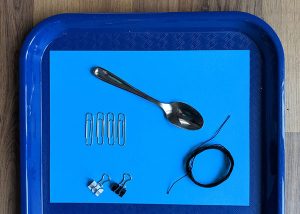 Suggested Materials:
Suggested Materials:
- Fishing line or smooth thread*
- Paper clips (4)
- Binder clips (2)
- 3”x5” notecard or 1 piece of paper
- Metal spoon
*Build the zipline by tying string between two objects of different heights, like the top of the back of a chair and the lowest handle on a cabinet. Make sure the zipline is at least one meter long.
STEM Concepts: You’ll need to make sure that the spoon is able to balance and that there is not too much friction between the zipline and your cart – friction slows objects down!
Extensions: Can you create a cart that carries the spoon on top of the zipline? What happens if you change the orientation of the spoon? What else can you send down your zipline?
THE ENGINEERING DESIGN PROCESS
Define the Challenge: Design a cart that will move a metal spoon safely down a zipline.
Plan Your Design: With the materials you have, what would you like to try? What sort of tool would be helpful?
Create a Prototype: A prototype is like a first try – see if you can build what you imagined.
Test your Creation: Does your creation balance on the line? Does the spoon stay attached? How fast does it go? If it didn’t do what you expected, what happened?
Improve Your Design: What could you change to make your design even better? Are there other materials that could help?
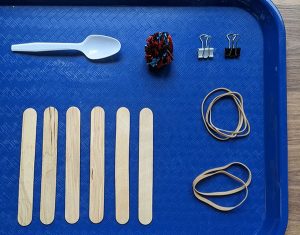 Suggested Materials:
Suggested Materials:
- Rubberbands (4 small, 2 large)
- Spoon (non-metal)
- Popsicle sticks (6)
- Binder clips (2)
- Pom pom or cotton ball
STEM Concepts: Rubberbands store up energy, called potential energy, when they’re stretched out. When they SNAP! that stored energy turns into kinetic energy, the energy of motion.
Extensions: How far can you make your pom pom travel? Are there other materials that you could use to help it go farther? What happens if you launch a ping pong ball or other object?
THE ENGINEERING DESIGN PROCESS
Define the Challenge: Design a tool that will launch a pom pom across the room. Your Design: With the materials you have, what would you like to try? What sort of tool would be helpful?
Plan Your Design: With the materials you have, what would you like to try? What sort of tool would be helpful?
Create a Prototype: A prototype is like a first try – see if you can build what you imagined.
Test your Creation: Does your launcher work? How far did the pom pom go? Try measuring the distance that the pom pom flew. If it didn’t do what you expected, what happened?
Improve Your Design: What else do you want to try? What could help your pom pom fly further?
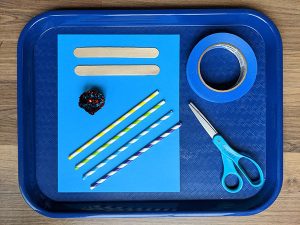 Suggested Materials:
Suggested Materials:
- Straws or pipe cleaners (4)
- Popsicle sticks (2)
- 1 piece of construction paper or cardstock
- Tape (20 cm)
- Scissors
- Ping pong ball or cotton ball
STEM Concepts: You’ll need to figure out a way to hold a sphere (a ball shape) in place so that it doesn’t roll off of your tool. Which materials are most useful?
Extensions: Can you create a tool with moving parts that lifts the ping pong ball? What else can your tool carry?
THE ENGINEERING DESIGN PROCESS
Define the Challenge: Build a tool that can pick up a ping pong ball with one hand, without touching it directly.
Plan Your Design: With the materials you have, what would you like to try? What sort of tool would be helpful?
Create a Prototype: A prototype is like a first try – see if you can build what you imagined.
Test your Creation: Could you pick up the ball with your tool using only one hand? Did it roll away, or fall off/out of your creation?
Improve Your Design: What other materials could you try? What shapes work well to grip the ping pong ball?
Interested in taking it further? Try making a claw with joints – you can do some research on articulated hand STEM challenges for inspiration!
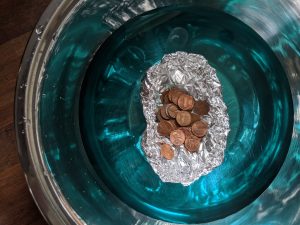 How many pennies (or pebbles) can you keep afloat on your foil boat?
How many pennies (or pebbles) can you keep afloat on your foil boat?
Suggested Materials:
- Aluminum foil (1x 12” x 12” square per boat)
- Pennies or pebbles
*To explore displacement, fill a cup all the way to the very top. Then, drop in an object that sinks! The water that spills out of the top of the cup is displaced. If you want to learn more, try investigating buoyancy and density.
STEM Concepts: Boats can only float if they weigh less than the amount of water that they displace, or push away. Bigger boats can displace more water than smaller boats.
Extensions: What shapes of boats work the best? Can you build a boat out of different materials?
THE ENGINEERING DESIGN PROCESS
Define the Challenge: Design a tin foil boat and see how many pennies or pebbles it can carry.
Plan Your Design: What shape are boats usually? Which boat shape do you think displaces the most water?
Create a Prototype: A prototype is like a first try – see if you can build what you imagined.
Test your Creation: Did your boat float on its own? How many pennies or pebbles could you add before it sank? What changes did you see as you added more weight?
Improve Your Design: Make changes to your boat so that it will hold even more pennies. Test out different shapes and sizes – could you try making it taller? Wider?
